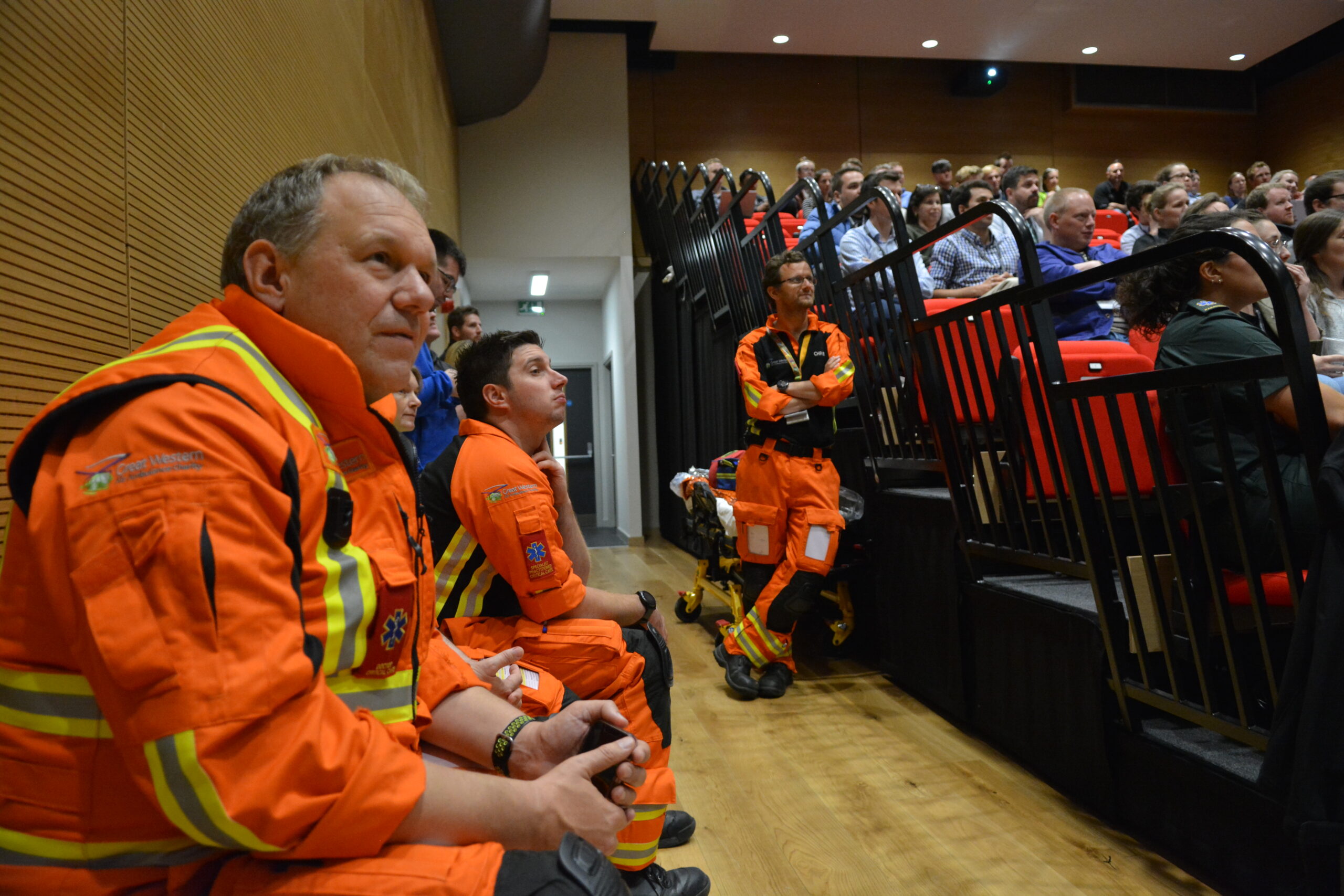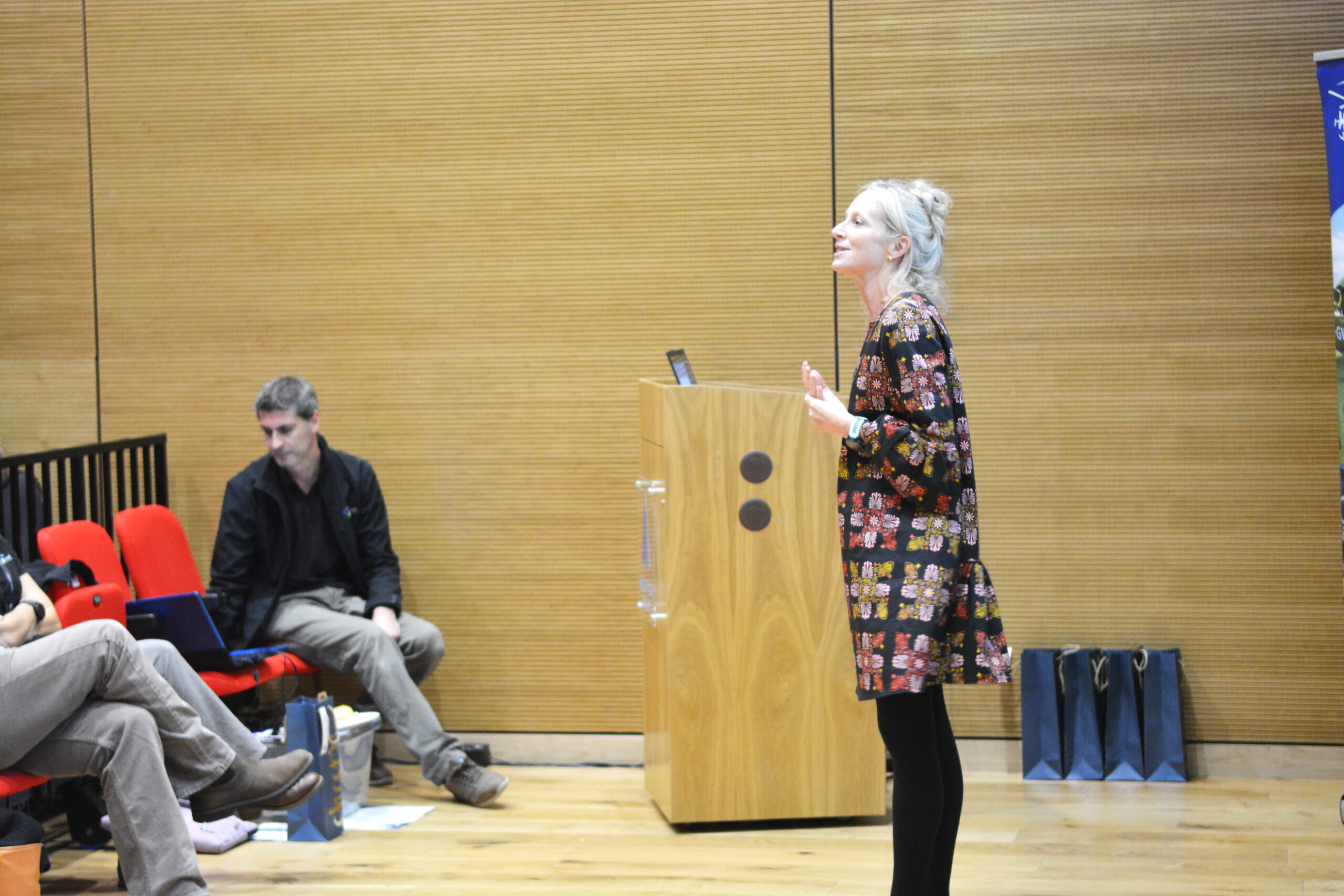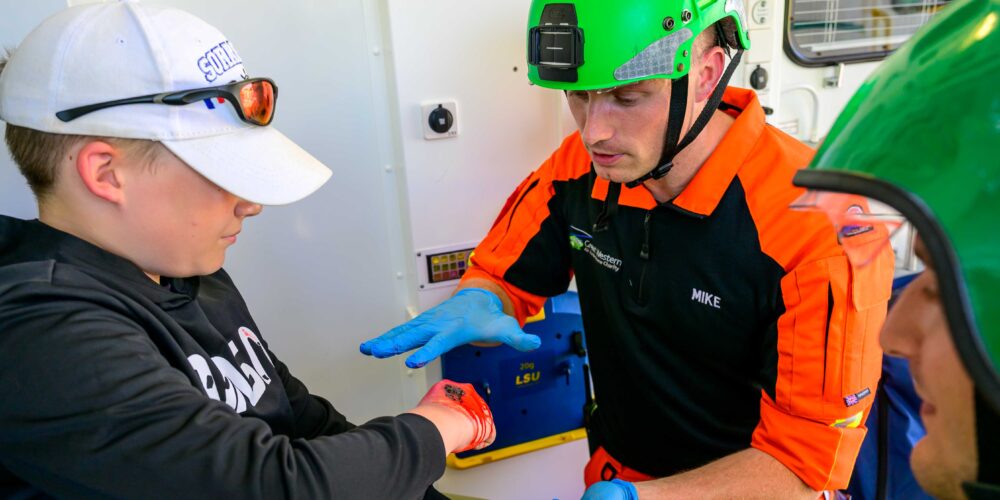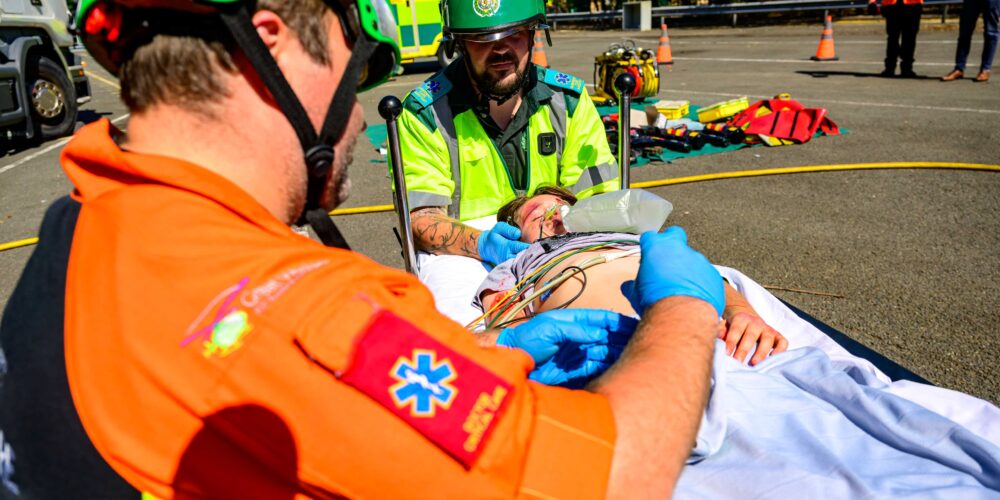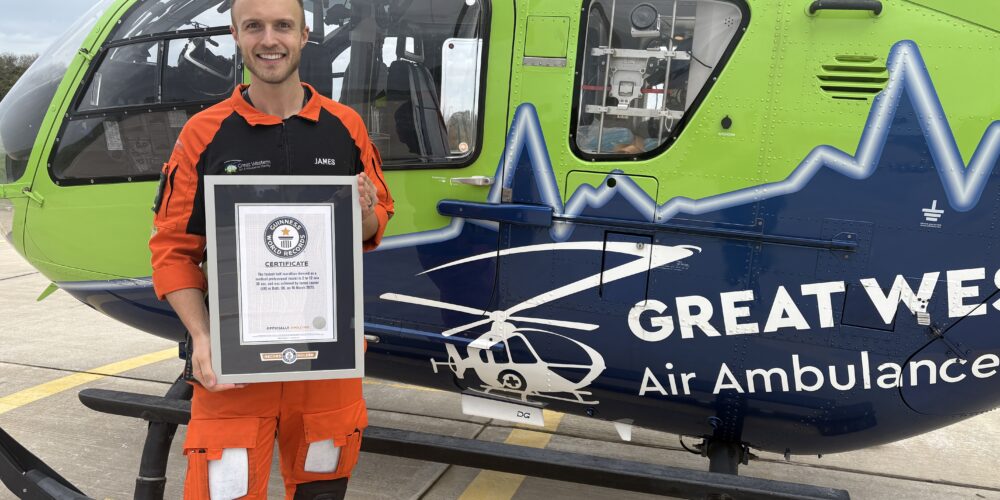
Training search and rescue teams in Norway
October 6, 2022
Cathy’s Story
October 13, 2022GWAAC Symposium 2022 – sharing knowledge with healthcare professionals
On Friday 16 September 2022, Bristol’s Aerospace Museum opened its doors to our crew, guest speakers and attendees for the return of the much-anticipated Pre-Hospital Emergency Medical (PHEM) Symposium – an informative and friendly conference for healthcare professionals wanting to learn more about all things PHEM-related.
The first Symposium was held in 2016 but the last two events in 2020 and 2021 did not run due to COVID-19. It was great to get colleagues and medical professionals back together in a collaborative learning environment, with CPD certificates waiting at the end.
If you’ve ever wondered what the GWAAC Symposium is all about, read this blog for an overview of the day and how it benefits healthcare professionals.
What the attendees had to say…
“Every single speaker has brought a lot to the table for me. The ‘Pushing Boundaries’ talk was very eye-opening, and I’ve also learned that the procedures we’re using now might change in the next ten years.”
Natalie Cunningham – Emergency Care Assistant
“Seeing the Critical Care Team in action was truly a sight to behold. They ran the case like a well-oiled machine. It was very inspirational to see!”
Dr Zain Mitha – Junior Doctor, Intensive Care Unit
“There are different speakers every year. It’s a good opportunity to hear what the latest developments are in pre-hospital care. And it’s good to develop my knowledge even though I don’t work in pre-hospital care.”
Dr Matthew Williams – Registrar, Emergency Department
Coffee, Concorde and Conversations
After half an hour of meeting and greeting and drinking coffee in the Concorde hangar (next to GWAAC’s old home at Filton Airfield), the attendees moved upstairs to the mezzanine level and took their seats to listen to a warm welcome by our CEO, Anna Perry, and Medical Director, Ed Valentine.
Anna and Dr Ed briefed the audience on what they could expect from the day – an array of expert speakers from varied backgrounds over four sessions. During the breaks, there would be excellent refreshments, an opportunity to look around trade stands and a peek inside Concorde itself.
To help get the audience into a pre-hospital headspace, Dr Ed played a fast-paced insightful video that gave a glimpse into life as a GWAAC crew member. The video showed the crew getting ready for a mission, followed by a simulation of their response to a Road Traffic Accident (RTC).
With the audience’s eyes a little wider, session one got underway…
SESSION ONE
Topic: Critical Care Transfers: What is it all about?
Speaker: Doctor Scott Grier, Lead Consultant, Retrieve Adult Critical Care Transfer Service and National Critical Care Transfer Lead, NHS England
Dr Grier opened his talk with a history of the Critical Care Transfer Service and how far it’s come since 2019. He explained that Retrieve is designed to take into account the geographical challenges of the South-West and he outlined the types of patient scenarios that Retrieve can help with.
The audience learned about what is involved in the transfer of a patient and why a comprehensive checklist is required. They also learned that 20,000-25,000 patients are moved every year in England (30,000-35,000 in the whole of the UK).
Dr Grier continued his talk by explaining how Retrieve has made a significant impact on the safe transportation of patients in the South-West. As he closed his presentation he talked about the “halo effect” and how the service is building on relationships and collaboration within hospitals and with other healthcare services. “The trajectory,” he said, “is here to stay.”
ECMO: Is it Useful in the Pre-Hospital setting?
Speaker: Dr Julian Thompson, Consultant in Intensive Care and Pre-Hospital Care, and Critical Care Doctor, GWAAC
Dr Julian shared an inspirational true story that highlighted how “Knowledge and expertise can achieve incredible things.” The story was of a doctor’s refusal to give up on a group of patients in cardiac arrest and how his actions and the use of Extracorporeal Membrane Oxygenation (ECMO) meant that everyone survived.
He pointed out that the medical boundaries that we perceive now, might not be the boundaries we perceive in ten or twenty years’ time. Dr Julian went on to talk about the advances in ECMO and whether using ECMO in a pre-hospital setting with Helicopter Emergency Medical Services (HEMS) would be viable in the future.
Pushing Boundaries
Speaker: Ms Vicki Brown, Advanced Clinical Practitioner in Critical Care (APCC), GWAAC, and Consultant Practitioner in Pre-Hospital Emergency Medicine (FPHC)
“I’ve always wanted to do as much as I can for the patient. And I’ve always wanted to push the boundaries of the paramedic service.” Vicki Brown, APCC.
Vicki took the audience on her journey to becoming an APCC through to getting on the Faculty of Pre-Hospital Care Register of Consultant (Level 8) Practitioners. She discussed the highs and lows and the challenges she faced.
With high ambitions for the future of paramedicine, Vicki is helping to make the pathway smoother for others to follow in her footsteps. She talked about her role as Education Lead for GWAAC and her aim to give all trainees the right opportunities for their careers.
When asked if she had any advice for new paramedic trainees, Vicki said, “Enjoy learning and don’t rush it. We think it will take around 12 years from qualifying as a paramedic to reaching consultant practitioner level.”
SESSION TWO
Topic: Claims, Inquests and the Regulator from a Pre-Hospital Perspective
Speaker: Mr Mark Faulkner, Consultant Paramedic, London Ambulance Service.
Mr Faulkner’s session made the audience aware of the increasing number of inquests around the pre-hospital management of patients. He explained the difference between civil and criminal claims and talked about clinical negligence.
In relation to a breach of duty, and with examples of legal cases, Mr Faulkner talked through topics such as liability, causation and compensation. He highlighted the importance of comprehensive clinical records.
He went on to explain the role of the coroner and finished with some useful hints and tips for the audience in the event they are asked to submit a coroner’s statement.
Topic: Gardening V Carpentry: Designing a Wellbeing Strategy
Speaker: Mr Pete Reeve, Air Operations Officer and Specialist Paramedic in Critical Care (SPCC), GWAAC
Pete’s message was that a wellbeing strategy needs to be intrinsically part of everything that an organisation is, and does. He said, “Everything we do at GWAAC is our wellbeing strategy. It has to be implicit, not explicit.” He used an analogy to help the audience understand:
“Wellbeing,” Pete said, “should be like a gardener, rather than a carpenter: a carpenter selects his wood and knows what the end product will be, while a gardener knows what they want to grow but needs to provide the right conditions to get the end product.”
Pete ran through GWAAC’s wellbeing programme and spoke about how shift check-ins and check-outs could potentially make the biggest difference to an emergency response team’s wellbeing at a station level. He was keen to point out that it can take a while for the change to feel comfortable, maybe up to six or twelve months. Pete said, “When you ask someone to be vulnerable, it can be quite scary, especially for those whose worlds are not warm and safe places.”
SESSION THREE
Topic: Bumps and Bruises
Speaker: Dr Tracy-Louise Appleyard, Consultant in Obstetrics and Gynaecology and Defence Consultant Adviser O&G
A short clip from the television series, This is Going to Hurt, set the scene for the humorous but insightful talk by Dr Tracy-Louise Appleyard.
She advised the audience that it’s better to assume all women are pregnant until proven otherwise.
Dr Appleyard went on to explain that women can be good at hiding problems so it’s important to look for the subtle but early warning signs that something is amiss. She talked about the importance of recognising when a woman is 20+ weeks pregnant and gave some tips on responding to out-of-hospital cardiac arrests in pregnant women.
“It’s important to have an organised multi-disciplinary approach when managing a pregnant woman,” she said. “Because even the most experienced medics can experience heightened emotions when they discover their critically ill or injured patient is pregnant.”
Topic: Interactive case
Speaker: Dr Ed Valentine, Medical Director, GWAAC, and Consultant in Emergency and Pre-Hospital Care
Using an online tool, Dr Ed ran an interactive scenario discussion with the audience casting votes on the correct courses of action.
One scenario described an incident where a 45-year-old male had driven into a lamppost. Dr Ed talked through the details and asked the audience how best to extricate the patient. The majority vote went to self-extrication. Dr Ed agreed and confirmed why this was the best course of action.
Other scenarios led to conversations around:
- whether giving adrenalin improves a patient’s chance of survival
- if mechanical Cardiopulmonary Resuscitation (CPR) is better than manual
- what is necessary for a HEMS landing site
- how would a patient best be transferred from scene to the nearest trauma hospital
- which monitoring modality is most useful during air transfer
Topic: Great Western Air Ambulance Charity DEMONSTRATION
Speaker: Dr Phil Cowburn MBE, Consultant in Emergency and Pre-Hospital Care, and Acute Care Medical Director, SWASfT, and Critical Care Doctor, GWAAC
Dr Phil set the scene for a GWAAC demonstration — a simulation of their response to a 24-year-old man who had fallen from a height of approximately 15-20m. SWASfT had responded and requested help from GWAAC. The man had a head and facial injury, an open ankle fracture, and was bleeding into his airway. As the crew leaped into action, Dr Phil explained what decisions were being made and why.
The simulation was fast-paced and impressive, and the team worked seamlessly together. Each crew member took control of a different aspect of treatment while communicating throughout.
The demonstration showed the audience what GWAAC can bring to an incident and what the crew can do to help improve a patient’s chance of survival.
SESSION FOUR
Topic: Keynote — Pre-Hospital Critical Care; Where Have We Come From and Where Are We Going?
Speaker: Professor Jonathan Benger CBE, Consultant in Emergency and Pre-Hospital Care, and first Medical Director and founding Critical Care Doctor for GWAAC
“There’s a saying,” began Professor Benger, “The only constant in the NHS is change.” Professor Benger talked about the history of the ambulance service and how pre-hospital critical care evolved to support it. He touched upon the good work that has been done to build relationships with land paramedics and pointed out that some myths still persist such as the helicopter being the fastest method of transport and HEMS being solely a patient transfer service.
He highlighted that, at GWAAC, “We do more for the patients we don’t see, than for the ones we do.” Training and education, he explained, are a huge part of what GWAAC does.
Professor Benger ended his session by looking to the future. He said the future of pre-hospital critical care may lie in a more blended community response – maybe along the lines of the European model with more doctors in land ambulances. But he also acknowledged the impact this would have on the paramedic profession and that changes would be needed for career pathways.
Topic: Manchester Arena Public Inquiry and Reflections on the Duty of Care
Speaker: Mr Christian Cooper, Head of Operations (NHS/National Ambulance Resilience Unit), and National Ambulance Expert for Manchester Inquiry.
The main message from Mr Cooper was that public inquiries are on the increase with a significant focus on the emergency services’ response to major incidents. Evidence of competence from individuals is being increasingly sought.
Mr Cooper explained that in the 1980s recurrent themes of concern cropped up during inquiries: the effectiveness of communications, the coordination of services and the provision of adequate care.
The Manchester Arena Inquiry threw up the same concerns. Mr Cooper said the good news is there are solutions in the pipeline; solutions that any of the emergency services can pick up.
Topic: Hot, Wet and High: Trauma and Extremes
Speaker: Dr Paddy Morgan, Critical Care Doctor, GWAAC, and Consultant in Anaesthesia and Pre-Hospital Care
Dr Paddy spoke about the difficulties of dealing with patients in extreme temperatures. He ran through some common problems with a patient subjected to extreme temperatures and conditions such as oxygen intolerance and fluid retention.
He explained that patients deal with extremes very differently. A farmer, for example, might refer to a leg hanging off as “a little injury” because they are used to enduring harsh conditions and a physical lifestyle. In other words, they have an ability to cope with trauma. With this knowledge, the GWAAC crew might respond differently to a farmer with “a little injury” than to an office worker with the same.
Dr Paddy closed his session by reflecting on the possibilities of providing better care to patients in the future. He said if we can take population learnings about the body’s response to trauma and extremes and then apply them to individuals in the form of bespoke treatment, outcomes could be improved.
“Seeing the Critical Care Team in action was truly a sight to behold. They ran the case like a well-oiled machine. It was very inspirational to see!”






